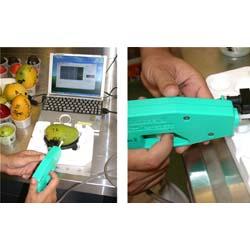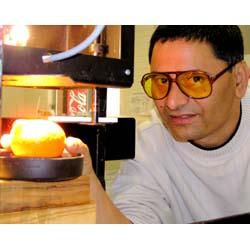Tasty research without a bite
Published on 08 June, 2005
A Central Queensland University PhD researcher is looking at new ways to test fruit quality using Near Infrared Spectroscopy (NIRS).
NIRS is commonly used in fruit packing houses to determine sweetness in fruit, but CQU’s Phul Subedi is researching the use of this non-invasive technique to determine fruit eating qualities other than sweetness, such as dryness defect, acidity, firmness and starch content.
 Have you ever peeled a mandarin to find dry segments inside? Or found a piece of fruit with acidity? Or may be you have thought a banana or mango was ripe for eating, to find that it was still starchy?.
Have you ever peeled a mandarin to find dry segments inside? Or found a piece of fruit with acidity? Or may be you have thought a banana or mango was ripe for eating, to find that it was still starchy?.
Mr Subedi’s research hopes to allow us to tell the quality of the fruit before the final taste test.
He recently won a travel grant of US$600 towards attendance of the 12th International Conference on NIRS held in Auckland, New Zealand. The award was granted by the International Committee for Near Infrared Spectroscopy (ICNIRS).
The award enabled Mr Subedi to make an oral presentation on his Chemometric techniques to an NIRS ‘master class’ audience, in addition to a poster presentation.
 Mr Subedi is a horticulture lecturer at Tribhuwan University, Institute of Agriculture and Animal Sciences in Nepal, however he is now an international student in Rockhampton undertaking his PhD degree under the supervision of Associate Professor Kerry Walsh and Professor David Midmore.
Mr Subedi is a horticulture lecturer at Tribhuwan University, Institute of Agriculture and Animal Sciences in Nepal, however he is now an international student in Rockhampton undertaking his PhD degree under the supervision of Associate Professor Kerry Walsh and Professor David Midmore.
Photo left: Phul Subedi uses the NIR spectrometer to test the quality of a mango.
Photo above: Phul Subedi scans normal and dryness defect mandarins using bench top NIR spectrometer.

